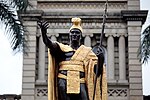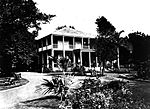Myron B. Thompson Academy
Myron B. Thompson Academy, commonly referred to as Thompson Academy or MBTA, is an e-learning institution operating as a "New Century Public Charter School" under the Hawaiʻi Department of Education. Thompson Academy is the result of a white paper study developed by the school's principal, Diana Oshiro, detailing the feasibility of a school delivered over the internet. Established in 1999 as Hawaii e-Charter, Thompson Academy is available to students across the state of Hawaiʻi exclusively through the internet, as an alternative-of-choice to local schools. The school is currently accredited by the Western Association of Schools and Colleges.
Excerpt from the Wikipedia article Myron B. Thompson Academy (License: CC BY-SA 3.0, Authors).Myron B. Thompson Academy
Richards Street, Honolulu Hawaii Capital Historic District
Geographical coordinates (GPS) Address Nearby Places Show on map
Geographical coordinates (GPS)
| Latitude | Longitude |
|---|---|
| N 21.30762 ° | E -157.8596 ° |
Address
YWCA Oahu (Laniakea)
Richards Street 1040
96813 Honolulu, Hawaii Capital Historic District
Hawaii, United States
Open on Google Maps










